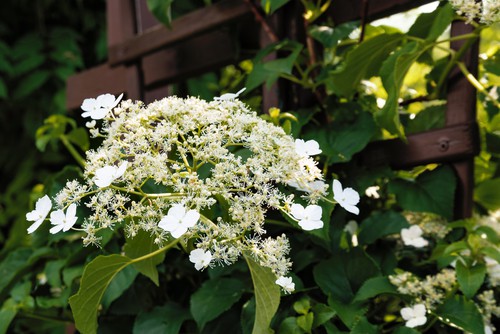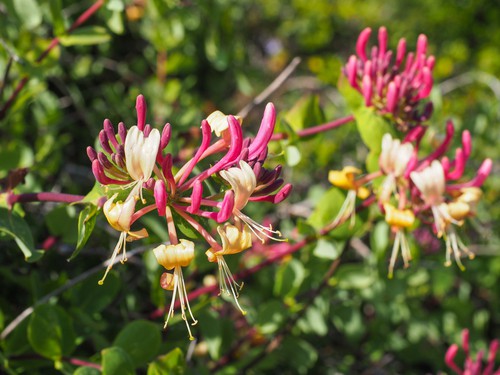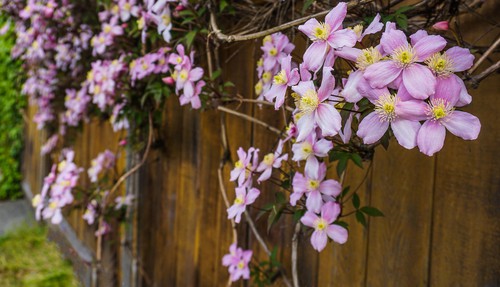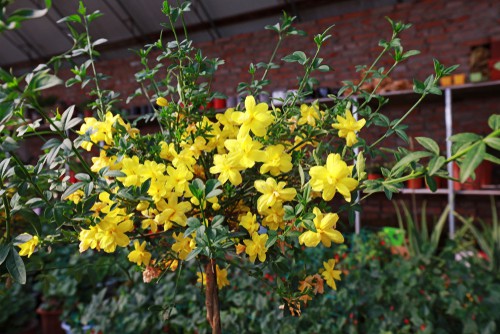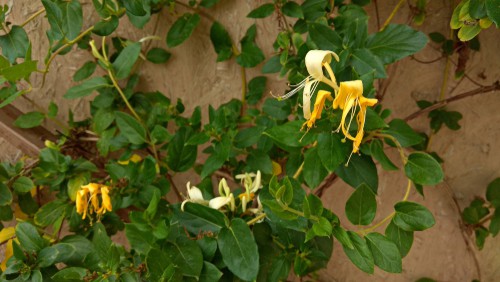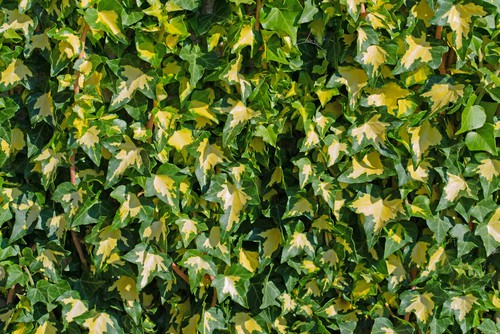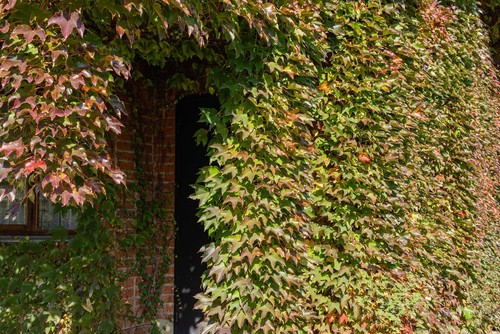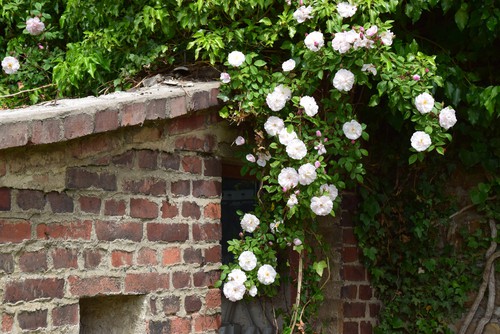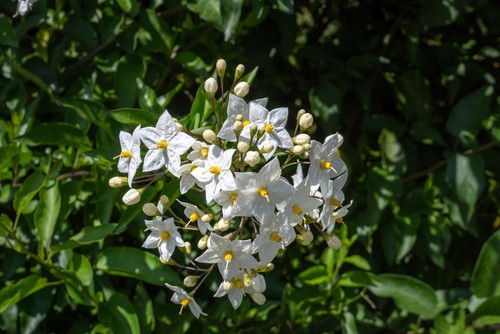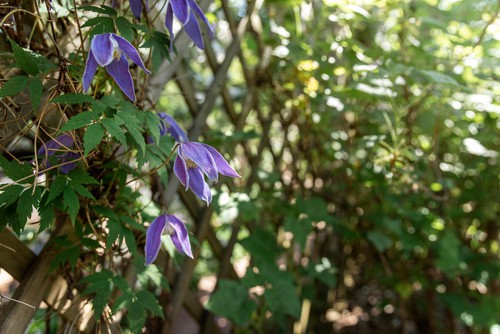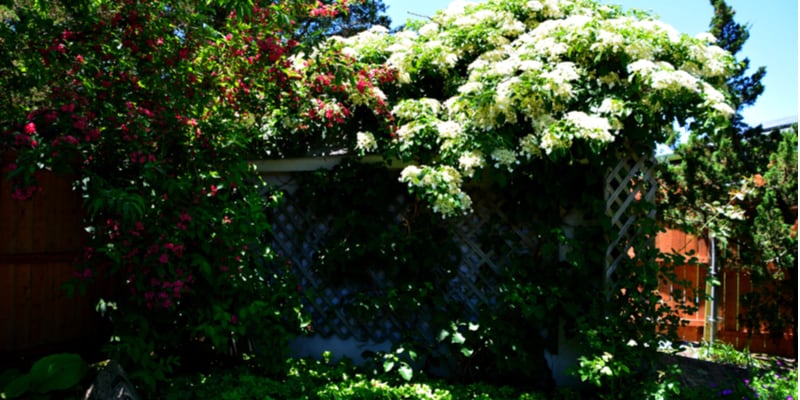
10 Best Climbers For Shade – For north facing walls and under trees
Our site is reader supported, this means we may earn a small commission from Amazon and other affiliates when you buy through links on our site.
Shady corners in the garden are overlooked because many people believe plants don’t thrive in the shade. You will be amazed to know that there are several climbing plants that thrive in the shade, presenting blooms or intriguing foliage patterns.
If you are interested in brightening up shady areas of the garden, consider the plants below:
1. Hydrangea anomala petiolaris
The presence of Hydrangea anomala petiolaris cannot be ignored because its beauty cannot be hidden. Nicknamed the Climbing Hydrangea, this deciduous plant is popular due to its bright appearance. The plant, which blooms from June through August, displays bright lace-like white flowers that complement the dark green foliage.
While supported by trellises or frames, the large climber creates an unforgettable display on walls, brightening up shady areas of the garden. The plant can tolerate full sun but preferably flourishes in partial sunlight, making it ideal for a shady corners. The vigorous climbing hydrangea does well in moist, neutral or acidic soils such as sand, loam, and clay full of nutrients.
You will not regret growing this climber because it also displays a beautiful picture in fall with golden-yellow foliage and a red-brownish trunk in winter. It grows to a height of over 10 metres and is propagated by layering, which would be ideal for fences, dull walls, or any outdoor surface that needs brightening up.
2. Lonicera periclymenum (Honeysuckle)
Taking after the delicious scent of honey, the fragrant Lonicera periclymenum is a lover of partial sunlight and moist, well-drained soils. Reaching a height of around 7-metres, the fragrant climber presents white to yellow creamy blooms with an external purplish-reddish colour in summer.
After blooming in late summer, the plant brings forth red berries in autumn, which are considered inedible and slightly poisonous.
The low maintenance plant only requires light pruning after blooming to thrive, as it is typically pest and disease resistant which is a big plus. Enjoy your summer days with this beautiful and deliciously scented plant, ensuring you support its weight using trellises, arches, or pergolas. They are also great for growing under and in through trees.
3. Clematis montana
Clematis plants are known for their stunning appearance, and the clematis montana is no different. This deciduous variety is a vigorous grower that loves moist acidic or neutral, well-drained soils. Armed with an abundance of white or pink flowers, the plant starts blooming in spring and continues into early summer. The flowers are not large, but their vibrant colour pops from the green foliage background.
Tolerating both full and partial sunlight, clematis montana is not hard to grow. The plant, however, needs structural support to create a good display as it is a climbing plant; otherwise, the plant would spread on the ground.
It flourishes to a 12 metres height, but you can control its vigorous growth through occasional pruning. For this variety, pruning is done according to group 1 pruning, which is after flowering and the risk of frost is no longer viable. The good news is they only need a light trim and no complicated pruning techniques are needed. It’s as close as you get to a maintenance free clematis or climber for that matter.
No products found.
Read next: Best clematis for shade
4. Jasminum nudiflorum
Vibrant, and easy to manage, the Chinese call this plant “the flower that welcomes winter.” This is because the plant presents bright yellow blooms in winter, forging on to early spring. The deciduous plant’s trifoliate blooms are small, but their brightness is undeniable as they decorate dull spaces with ease.
Even if you place the plants in a section where the sun doesn’t shine all the way through, do not worry. Jasminum nudiflorum grows well in full or partial sunlight with the support of moist, and fertile, well-drained soils. The plants prefer loam sandy soils, but they can tolerate various soils with neutral, alkaline, or acidic pH.
In terms of maintenance, the plants need pruning after blooming is complete, which is around early spring. Jasminum nudiflorum has few problems with pests, but sometimes mealybugs and aphids may take a liking to them.
Cascading vines down trellises and walls, this clump-forming plant grows to 2.5 meters or more in height and spread. You can easily propagate them through semi-hardwood cuttings harvested in summer or early autumn.
Read next: Best climbers for pots
5. Lonicera japonica ‘Halliana’
Commonly identified as Japanese honeysuckle, Lonicera japonica ‘Halliana’ is a sight to behold. The flowers usually emerge as white flowers before morphing to a yellow hue as spring ends into early summer. Paired with the lush green foliage, the tubular flowers are attractive enough to attract pollinators such as bees and butterflies.
The plant originating from Asia grows in simple conditions requiring sunlight, moist, well-drained soils, and average watering. Like its counterparts, Japanese honeysuckle produces a distinct, pleasant aroma that will fill your atmosphere. The low maintenance plant needs pruning occasionally to remove dead or diseased branches. It is advisable to cut the plant back hard in late winter to allow the incoming growth to flourish with vigour.
This plant is propagated through layering or softwood cuttings and is considered an invasive species in some parts of the world like the US.
Read next: Looking for Fast growing climbers? read my guide here in the best varieties
6. Hedera (Ivy)
Ivy has a reputation for taking over and causing damage when it gets out of control; however, they are also stunning plants, especially in autumn where the clusters of small green flowers appear but some varieties have stunning foliage too. The greenish-yellow flowers offer a contrast to the dark green leaves, presenting a gentle but noticeable display.
One of the more notable things other than the clusters of tiny flowers is the glossy foliage. The foliage typically displays veins that are lighter in colour making them more conspicuous. The light green veins morph into an intriguing light bronze or red-based colour in autumn.
Growing to a height of 12 meter, these evergreen plants are drought resistant and very easy to grow. They can tolerate different soils with varied pH scales as long as good drainage is available, what this basically means is that they will pretty much grow anywhere. Furthermore, these plants grow in fully shaded as well as open sunny areas, making them suitable for gardens or areas that access little sunshine.
Pruning is not necessary, but you can reduce the size of long shoots to maintain the plant’s shape and stop them from getting too large. The ideal time to prune would be around spring before new growth appears. Also, fertilise the plants in spring and summer to support the incoming blooming season in autumn.
7. Parthenocissus (Virginia Creeper)
Parthenocissus offer remarkable foliage that will make a statement whether on a trellis or wall. These plants grow vigorously, taking any space they can find. Over 10 varieties of these plants exist, with Virginia creeper being its common name but they are often sold as Parthenocissus quinquefolia.
As said above, these deciduous climbing plants have interesting foliage, especially in autumn. The palmate or lobed leaves depending on the variety will feature different colours from red, yellow, and orange. This is regardless of whether you place them in a fully shaded area or where they can access some sun.
The leaves start with the typical green colour in summer and spring before morphing to the colourful phase. As leaves change colour in autumn, berries also appear, making the display even more captivating. They are not picky in terms of soil because they grow in any moist, well-drained and nutritious soil. Maintain the plants by pruning, which should be done as winter ends or as spring begins.
No products found.
8. Climbing Roses
If you are looking for fragrant climbing plants with stunning flowers, climbing roses will not fail to brighten any areas where planted. There are different varieties of climbing roses to choose from in terms of flower colour and the overall size of the blooms. Some varieties of climbing roses include Dublin Bay, Eden, Danse Du Feu, Rosa ‘Alchymist’, Souvenir Du Docteur Jamain, Clarence House, and Fourth of July among others.
Roses do not do so well in full shade, because ideal conditions include access to partial/full sunshine. Be careful about the soil you use because waterlogged soils will result in fungal diseases. Use fertile soils with good drainage for the roses to grow well.
If you use arbours, pergolas, or trellises, ensure the structure is strong enough to support the weight of the plant once matured. Climbing roses bloom in summer as well as autumn and could do with pruning in winter once flowering has finished. Deadheading throughout the season is encouraged to keep the plant producing more flowers.
9. Solanum jasminoides Album
If you like the smell of jasmine, you can try growing Solanum jasminoides Album, otherwise known as potato vine. Although the fragrance is not as strong, the beauty of the climbing plant is still worthwhile.
The plant produces star-shaped white blooms featuring yellow beaks from summer to early autumn. The flowers and dark green glossy foliage steal the show until purple/black berries emerge in autumn.
Growing this partially hardy plant (zone 4) needs well-drained, mildly alkaline, loam soils with enough nutrients to foster healthy growth. The semi-evergreen climber needs full sun to thrive, unlike other climbers on this list that can tolerate partial sunlight. It would be suitable to plant them on sunny walls or fences where they can get maximum exposure.
You have the choice of whether to plant them in the ground or pots because they do well in both situations. They grow to over 6 metres with a 2.5-metre spread and need occasional pruning which which can be done after the blooming season. Please keep your dogs and cats away from the plant as it is considered a poisonous plant to them.
Read next: How to plant climbers against a fence
10. Clematis Alpina, Clematis macropetala, and Jackmanii
There are various clematis cultivars easily accessible depending on where you are. Cultivars such as Clematis Alpina and Clematis macropetala bear small blooms, while varieties like Clematis Jackmanii display large flowers.
Clematis Alpina and Clematis macropetala are early flowering cultivars that manifest tapering blooms from late spring to the end of summer. These colourful cultivars (mostly purple hues) are trainable around different structures such as trellises, arbours, fences, and arches among others. They need partial/full sunlight, well-drained neutral or alkaline pH soils, and pruning in early spring to thrive.
The late flowering climber, Clematis Jackmanii, displays unforgettable dark purple blooms in summer. However, it needs to be cut back severely as winter ends or spring begins to rejuvenate the plant. Being that there are so many cultivars, take your time to select the most visually appealing variety according to you.
Conclusion
Most Climbing plants are fairly easy to grow and low maintenance once they are established. Pruning them occasionally will assist in maintaining a neat aesthetic and curb the fast growth that can invade other spaces. Undertake the challenge today and grow any of these climbers to transform your garden for the better.
Read next: Best hydrangeas for growing in a shady position
Last update on 2025-07-02 / Affiliate links / Images from Amazon Product Advertising API
